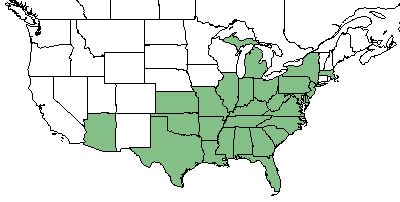Difference between revisions of "Juncus biflorus"
(→Conservation and Management) |
(→Distribution) |
||
| Line 27: | Line 27: | ||
==Distribution== | ==Distribution== | ||
| + | ''J. biflorus'' can be found in the Southeastern United States from Mississippi and up to Michigan as well as along the Atlantic coast to New Jersey. <ref name= "USDA"/> | ||
| + | |||
==Ecology== | ==Ecology== | ||
===Habitat=== <!--Natural communities, human disturbed habitats, topography, hydrology, soils, light, fire regime requirements for removal of competition, etc.--> | ===Habitat=== <!--Natural communities, human disturbed habitats, topography, hydrology, soils, light, fire regime requirements for removal of competition, etc.--> | ||
Revision as of 19:34, 22 May 2018
| Juncus biflorus | |
|---|---|
Error creating thumbnail: Unable to save thumbnail to destination
| |
| Photo by Gary Fleming at the Digital Atlas of the Virginia Flora | |
| Scientific classification | |
| Kingdom: | Plantae |
| Division: | Magnoliophyta - Flowering plants |
| Class: | Liliopsida - Moncots |
| Order: | Juncales |
| Family: | Juncaceae |
| Genus: | Juncus |
| Species: | J. biflorus |
| Binomial name | |
| Juncus biflorus Ell. | |

| |
| Natural range of Juncus biflorus from USDA NRCS Plants Database. | |
Contents
Taxonomic Notes
Synonyms: Juncus marginatus Rostkovius, and Juncus aristulatus Michaux var. biflorus (Elliott) Small
Varieties: none
Description
Also known as bog rush, J. biflorus is a native perennial graminoid that is a member of the Juncaceae family. It has a rapid rhizomatous growth form reaching a mature height of 3.5 feet. [1]
Distribution
J. biflorus can be found in the Southeastern United States from Mississippi and up to Michigan as well as along the Atlantic coast to New Jersey. [1]
Ecology
Habitat
Conservation and Management
J. biflorus is listed as endangered in the state of New York, and is listed as threatened in the state of Pennsylvania. [1]
Cultivation and restoration
Photo Gallery
References and notes
- ↑ 1.0 1.1 1.2 USDA Plants Database URL: https://plants.usda.gov/core/profile?symbol=JUBI